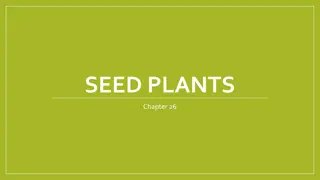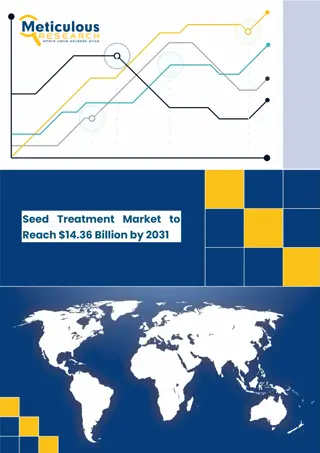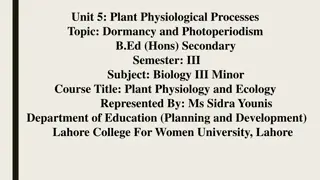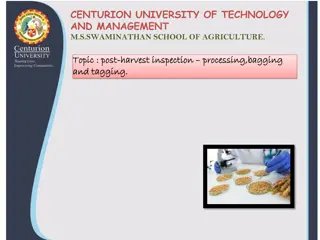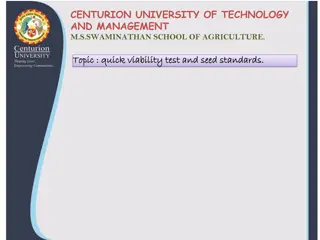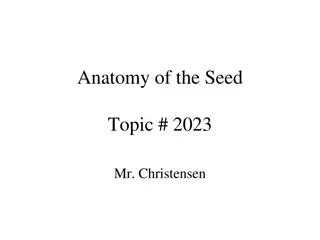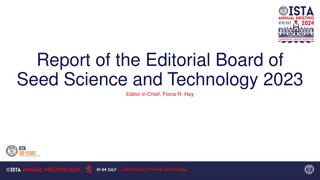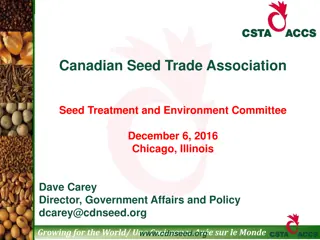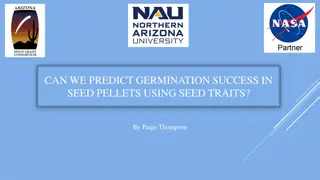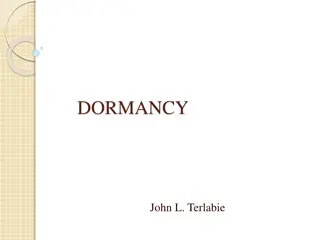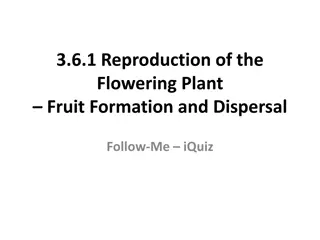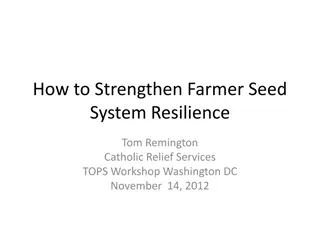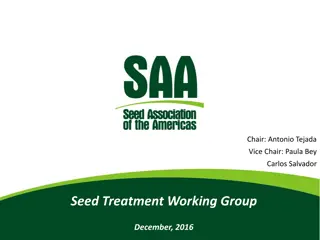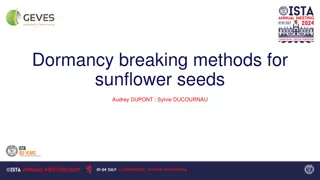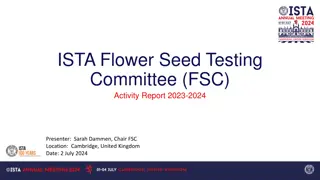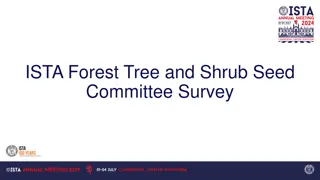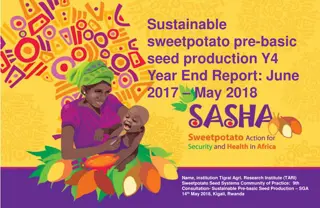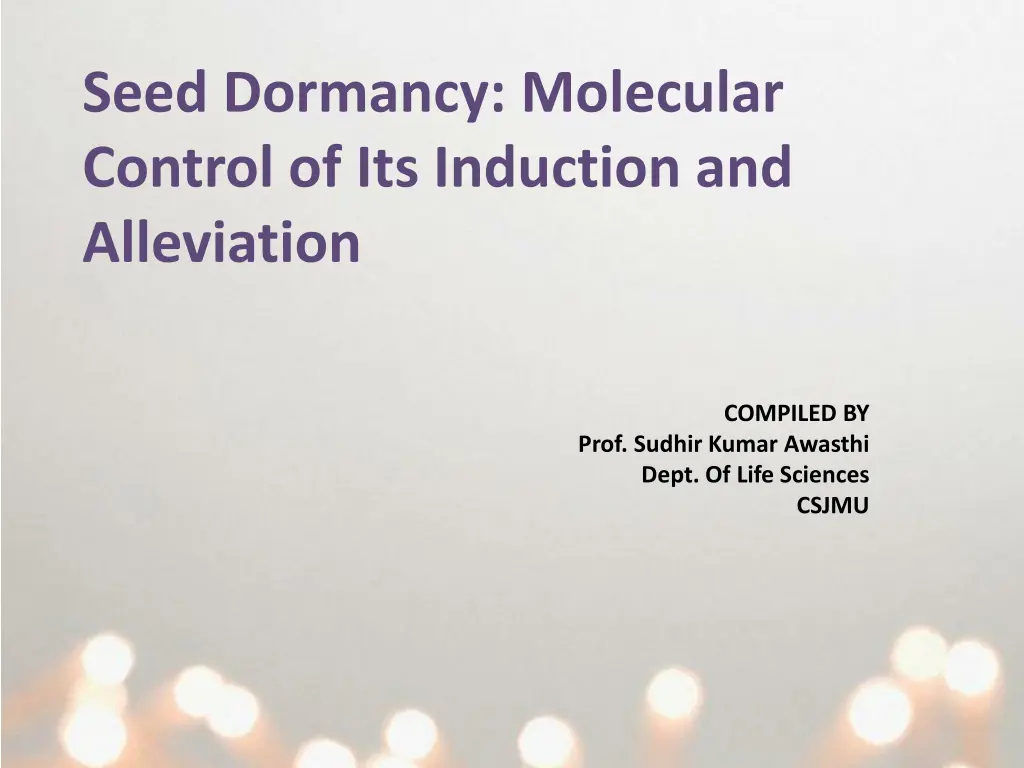
Molecular Control of Seed Dormancy Induction and Alleviation
Explore the molecular mechanisms behind seed dormancy, focusing on the role of the DELAY OF GERMINATION1 (DOG1) protein, epigenetic control, secondary dormancy, and phytohormones like ABA and GA in regulating germination. Understand the impact of environmental factors on seed dormancy and germination processes, crucial for plant adaptation and survival.
Download Presentation

Please find below an Image/Link to download the presentation.
The content on the website is provided AS IS for your information and personal use only. It may not be sold, licensed, or shared on other websites without obtaining consent from the author. If you encounter any issues during the download, it is possible that the publisher has removed the file from their server.
You are allowed to download the files provided on this website for personal or commercial use, subject to the condition that they are used lawfully. All files are the property of their respective owners.
The content on the website is provided AS IS for your information and personal use only. It may not be sold, licensed, or shared on other websites without obtaining consent from the author.
E N D
Presentation Transcript
Seed Dormancy: Molecular Control of Its Induction and Alleviation COMPILED BY Prof. Sudhir Kumar Awasthi Dept. Of Life Sciences CSJMU
Seed Dormancy: Molecular Control of Its Induction and Alleviation The seed, a key entity in the life cycle of higher plants, allows and ensures its survival by acquiring primary dormancy (PD) during maturation The DELAY OF GERMINATION1 (DOG1) protein was identified and characterized as a major regulator of seed dormancy. PD is the failure of seeds to germinate although environmental conditions are favorable. Interestingly, some PD-related genes are regulated through the epigenetic control of endosperm-specific gene expression Likewise, nondormant seeds can enter secondary dormancy (SD) upon exposure to unfavorable conditions for germination. Lack of light is a key factor involved in the induction of SD. However, it is not yet confirmed whether PD is a requirement to have the ability to acquire SD. Recently, it was demonstrated that SD is induced in both high- and low-dormancy genotypes and that SD is less responsive to after-ripening (AR) and cold stratification than PD Maternal ABA is the only phytohormone known to induce, regulate, and maintain PD , and ABA levels and ABA signaling play pivotal roles in the regulation of PD and germination
GAs balance is key to controlling PD and germination . Thus, seeds of ABA-deficient mutants germinate faster than the wild-type ones, and transgenic plants constitutively expressing the ABA biosynthesis genes maintain deep PD. Seed germination processes are under the control of classical phytohormones, reactive oxygen species (ROS), brassinosteroids, strigolactones , as well as temperature, nitrate, and light . Accordingly, PD and germination are strictly regulated by the modulation of suitable phytohormones, transcription factors, and environmental signaling networks . This regulation mechanism is supposed to be highly conserved . Together, PD and germination are two closely linked physiological traits that have great impacts on the adaptation and survival of seed plants. Although the phytohormones involved in these two traits have been largely identified, their mechanisms of interaction with external factors and how dormancy is broken under different conditions are more elusive.
Seed Dormancy and Delay of Germination-1 (DOG1) Protein Due to the great repercussion of seed dormancy in the life of the seed, a great deal of research and has been developed in the last few decades. One of the reasons, among several others, is the appearance of pre-harvest sprouting (viviparism) in the mother plant when PD is not triggered. Viviparism is an important problem in cereal production because it reduces crop yield and quality. In other words, knowledge of the initiation, maintenance, and loss of PD is key to understanding how the germination process is triggered.
The transcriptional and epigenetic control of dormancy, as well as the great advances in proteomics, have clarified a considerable number of PD mechanisms, which are essential to the survival of higher plants. The expression of DOG1 is widely regulated and increases during seed maturation. DOG1 protein levels accumulate during the last phase of embryogenesis and correlate with the depth of PD. However, although DOG1 is relatively stable, DOG1 mRNA disappears quickly after seed imbibition.
ROS and Nucleic Acid Modifications during Seed Dormancy Plants have to deal with ROS constantly generated in the cell organelles. Except for certain phases of the plant life cycle (e.g., dry viable seeds), the production of ROS is essentially associated with photosynthesis. When an excess of ROS is produced and a threshold exceeded (e.g., under stress conditions), cellular damage may arise and trigger cell death. To a greater or lesser degree, all ROS are markedly reactive. Thus, they are able to oxidize biological molecules, including lipids, DNA, RNAs, and proteins, RNA being more susceptible to oxidative damage than DNA. Interestingly, we now know that ROS is not always detrimental to the cell. This is what sometimes happens, for example, with the singlet oxygen (1O2). That is, the 1O2 generated in the light-harvesting complex (LHC) of the chloroplast
Grana core under excessive light energy, or in the photosystem II reaction center (PSII-RC) of the grana margins under low light energy, may act as a highly versatile signal (i.e., chloroplast-to-nucleus retrograde signaling (ChNRS)) triggering beneficial cell responses. To sustain life, an organism must maintain ROS homeostatic levels. This control involves more than 150 genes in Arabidopsis. In contrast, ROS has been correlated with a low degree of seed dormancy. When the ROS level reaches a certain threshold, dormancy is alleviated and the subsequent germination can be initiated. Likewise, seed aging takes place, and an intensive degradation of nucleic acids and proteins occurs. Interestingly, it was recently demonstrated that AtPER1, a seed-specific peroxiredoxin, eliminates ROS to suppress ABA catabolism and GA biosynthesis, and thus improves the PD and make the seeds less sensitive to adverse environmental conditions
Auxins and Seed Dormancy In addition to higher plants Auxins and Seed Dormancy In addition to higher plants auxin is a signaling molecule that is present in living organisms such as algae, moss, liverworts, lycophytes, and microorganisms. Auxin is involved in multi-functional processes during plant growth and development. Recently, auxin signaling was thoroughly reviewed Regarding the seed, it is now widely accepted that auxin biosynthesis is required for an array of seed developmental processes (e.g., embryogenesis and endosperm development, among others). Current studies have elucidated that auxin is also involved in the transition from PD to germination. Recent studies have shown that auxin possesses positive effects on seed dormancy, being (in conjunction with ABA) the second known hormone that induces seed dormancy.
Thus, it was demonstrated, for the first time at the molecular level, a role for auxin in PD through stimulation of ABA signaling, identifying auxin as a dormancy promotor The dynamic of expression and localization (i.e., proembryo, hypophysis, and suspensor) of several key genes for the biosynthesis and transport of auxins in the globular phase was carefully checked The bHLH49 transcription factor appears to be a notable mediator of the auxin-dependent suppression of embryo identity in suspensor cells. Likewise, synthesis, transport, and compartmentalization of auxins are crucial for the ovule, endosperm, and seed-coat (SC) development.
Auxin transport from the endosperm to the integuments is regulated by AGAMOUS-LIKE 62 (AGL62), the encoding gene of which is specifically expressed in the endosperm to suppress its cellularization. In the absence of Plants 2020, 9, 1402 4 of 6 AGL62 (i.e., agl62 mutants), auxin remains trapped in the endosperm and the SC fails to develop (i.e., seed abortion). The application of auxin represses soybean seed germination through decreasing the ABA/GA ratio. Jointly, it is suggested that auxin acts synergistically with ABA to promote PD and inhibit germination. Recent biochemical and genetic evidence supports the involvement of auxins in PD. In this process, the participation of the transcriptional regulator ABA INSENSITIVE3 (ABI3) is critical, revealing a cross-talk between auxin and ABA signaling. Recent information demonstrates that auxin acts downstream of ABA to promote seed germination. However, it is still unknown if any process exists in which ABA acts downstream of auxin. An exhaustive analysis of the auxin responsiveness of ABA biosynthesis, transport, and signaling mutants will be required for this
Effects of GABA on the Germination of Recalcitrant Seeds: Effects of GABA on the Germination of Recalcitrant Seeds: Implications on Primary Dormancy -Aminobutyric acid (GABA), a non-protein amino acid, is an important component of the free amino acid pool of living organisms. The enzymes involved in its metabolism are evolutionarily very conserved. Recently, the GABA implications in plant growth and development have been updated Thus, genetic and physiological studies have proven that GABA is involved in barley aleurone metabolism. Furthermore, the scant current evidence on the mechanism by which GABA acts as a signaling molecule in plants has been also reviewed .
The recent identification of a GABA receptor indicates that GABA is a signaling molecule and not just a metabolite [30]. Vigabatrin is a specific GABA transaminase inhibitor that inhibits GABA degradation. In this Special Issue, Du et al. [31] now report that high GABA levels exist in the chestnut recalcitrant viable seeds before germination. Likewise, they also suggest that endogenous GABA may play a specific role in the germination. Exogenous GABA and vigabatrin induced an accumulation of H2O2, possibly contributing to the inhibition of chestnut seed germination. In parallel, the authors point out that this inhibition may be due to an alteration in the balance between carbon and nitrogen metabolism, especially the free amino acid contents before germination. Together, the results presented here suggest that changes in GABA levels in chestnut seeds may prevent seed germination.
REFERENCES Seed dormancy & germination by J.W. Bradbeer (2000) Vishal, B.; Kumar, P.P. Regulation of seed germination and abiotic stresses by gibberellins and abscisic acid.(2018) Footitt, S.; Walley, P.G.; Lynn, J.R.; Hambidge, A.J.; Penfield, S.; Finch-Savage, W.E. Trait analysis reveals DOG1 determines initial depth of seed dormancy, New Phytol. 2019 Bailly, C. The signalling role of ROS in the regulation of seed germination and dormancy. 2019

